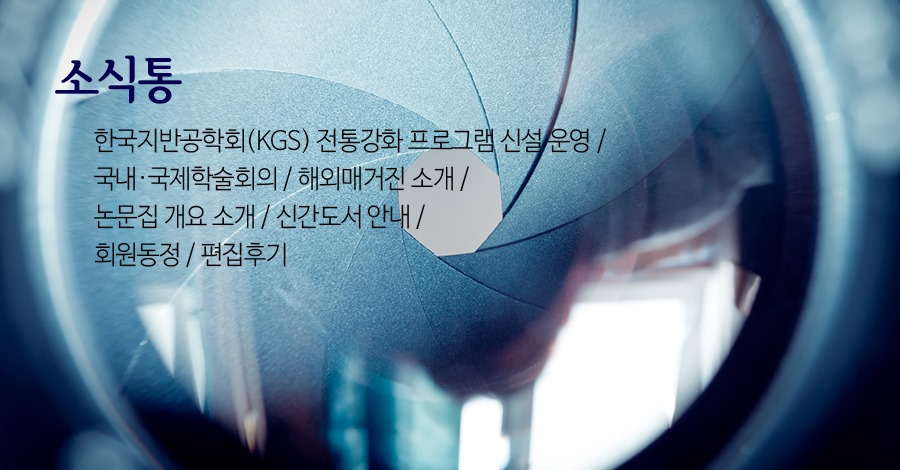한국지반공학회(KGS)전통강화 프로그램 신설 운영
학회 뉴스레터 2021년 12월호 지면을 통해 회원님들께 홍보 말씀드렸던 “한국지반공학회(KGS) 전통강화 프로그램”의 신설 및 운영 취지를 본 학회지 소식통을 활용하여 다시한번 말씀 드리고자 합니다. 학회 집행부에서는 다가오는 2022년 1월부터 “한국지반공학회(KGS) 전통강화 프로그램”을 신설하여 운영할 계획입니다. 학회 설립시기부터 지금까지 학회의 지속적인 성장과 발전을 위해 많은 노력을 기울여 주신 선배회원님들을모시고 고견과 지반공학의 역사를 듣는 것이 본 프로그램의 운영 취지입니다. 지금껏 학회활동을 통해 쌓아오신 연구개발 및 기술교류 업적과 함께 다양한 학술적 경험을 후배회원들께 전달, 공유하여 우리의 역사와 가치를 되새기고 이해하는데 보탬이 될 것 입니다.“한국지반공학회(KGS) 전통강화 프로그램”을 위해 국내·외 산학연에서 연구개발 및학술활동을 활발하게 진행 해 오신 선배(시니어) 회원님들의 현황을 사전에 파악하였습니다. 그 동안 쌓아오신 연구업적 및 경험을 살펴, 그 노하우를 봄·가을 학술발표회 강연과학회지 및 뉴스레터(동행)로 이어지는 학술 플랫폼을 통해 학회 회원들께 홍보해 드리고동시에 특별한 만남의 장을 마련하는 것으로 구성하고자 합니다(그림 참조).
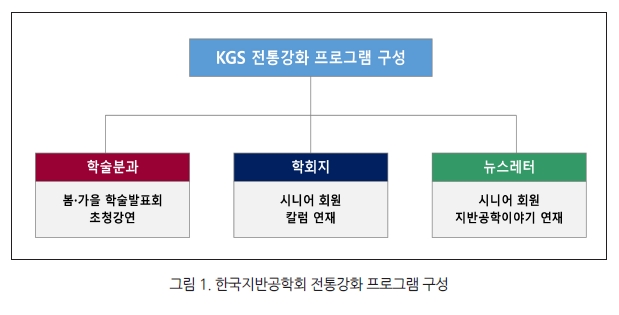
“한국지반공학회(KGS) 전통강화프로그램”의 운영 방식은 첫 번째학술분과에서 봄·가을 학술발표회“초청강연”의 진행(사진 예 참조),두 번째 학회지 “시니어 회원 칼럼연재”의진행, 마지막으로 뉴스레터(동행) “나의 지반공학 이야기-시니어 회원 시리즈 연재”로 진행될계획입니다. 특히 학회지와 뉴스레터(동행)를 통해 국내·외 대학/국책연구원/건설업계에서 종사 해 오신선배 회원님들의 전공 분야별 전문지식을 이해할 수 있고 다양한 연구경험을 함께 나눌 수 있어 교육적 가치가 클 것으로 기대하고 있습니다. 또한학회 선·후배 회원님들의 네트워킹 강화에도 기여할 것입니다. 본 프로그램의 활성화를 위해 회원 분들의 많은관심을 부탁 드립니다.
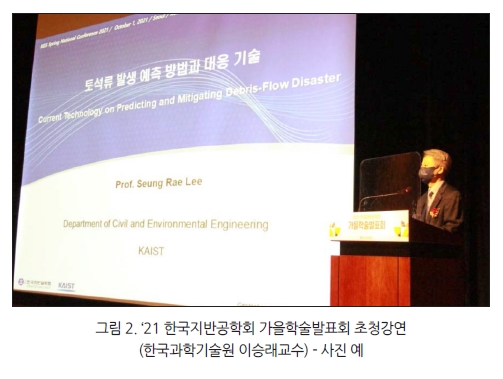
국내학술대회 소식
Korean Conference & Symposium
하천제방 공동심포지엄
우리 학회는 지반 2021년 12월 10일 한국수자원학회와 공동으로 “집중호우에 따른 토석류 및 하천제방의거동 공동 심포지엄’ 행사를 aT센터에서 개최하였다. 이번 행사는 지난 4월 21일 두 학회가 1차로 개최했던‘하천제방 관리기술 공동 심포지엄’에 이은 두 번째 행사로 하천제방과 관련된 연구에 지반공학과 수자원 분야의전문가가 공동으로 참여하여 지식을 공유하고 당면한 문제를 해결하기 위한 초석을 다지기 위해 준비되었다.코로나 방역지침에 따라 현장 참석인원 제한이 있었으나 심포지엄 시작 전 이미 행사장은 모두 가득 찼다.한국지반공학회 정문경 회장과 한국수자원학회 배덕효 회장의 개회사로 심포지엄은 시작됐다. 정문경 회장은집중호우에 따른 토석류 및 하천제방 거동은 외력을 다루는 수자원 전문가와 저항을 다루는 지반공학 전문가가함께 고민하여 해법을 제안할 수 있는 중요한 분야이며, 두 분야에서 접근하는 방법과 지식의 차이를 이해하고새로운 아이디어를 도출하길 기대한다고 하였다. 배덕효 회장은, 수자원과 지반공학적인 지식이 필요함에도 함께고민할 기회가 없었으나 이번 행사와 같이 지속적인 두 학회의 교류를 통해 토석류 및 하천제방과 같은 융복합연구에서 미래기술에 대한 고민을 함께하길 바란다고 하였다.개회사에 이어 총 6건의 주제발표가 진행되었다.
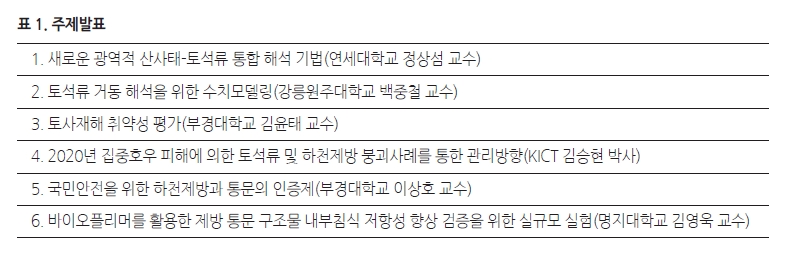
첫 번째로 연세대학교 정상섬교수가 ‘새로운 광역적 산사태-토석류 통합해석기법’ 이라는주 제 로 발 표 를 시 작 하 였 다 .2011년 우면산 산사태 사례를소개하며 다양한 토석류 기법의장단점을 설명하였다. 기존 모델들이 제한적으로 고려하는 연행작용, 산사태의 초기부피, 토석류의습윤 상태 등의 한계를 극복한새로운 산사태-토석류 연계해석기법을 소개하였다. 강우발생 이후불포화상태의 지반 형성과 습윤상태 발달, 이후 연행작용이 고려된지반의 이동과 퇴적 전반에 걸친프로세스가 고려된 모델의 이론적배경에 대한 설명 이후, 국내외사례와 비교하여 실질적인 토석류거동에 대한 해석 결과를 선보였다.산 사 태 와 토 석 류 의 연계해석기법의 적용과 검증을 통해 복잡한 지형에서 합리적인 예측결과 도출이 가능함을 발표하였다.
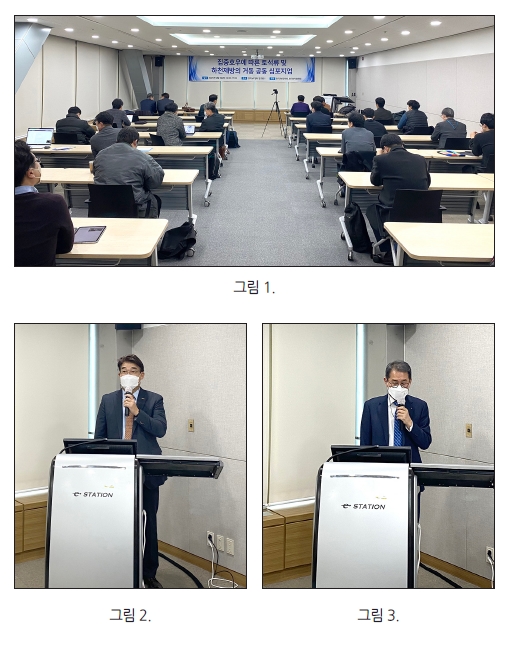
두 번째 발표는 ‘토석류 거동해석을 위한 수치모델링’의 주제로 강릉원주대학교 백중철 교수가 진행하였다.우면산 산사태 직후에는 지반공학과 수자원 분야에서의 관점과 접근법이 다르다고 느꼈으나 점차 두 분야의전문가 교류를 통해 같은 목적을 바라보며 연구를 수행하고 있다는 소회를 밝히며 발표를 시작하였다. 토석류의거동 특성 및 메커니즘에 대한 설명과 함수량 증가에 따른 토석물질 연행의 중요성을 강조하며 국외 실험사례를통해 수치모델의 적용성을 설명하였다. 이어서 천수방정식에 근거한 단상 흐름 수치모델링과 다상흐름수치모델링의 적용 사례를 소개하며, 산사태에 의해 야기된 충격파로 인한 영향범위 해석, 토석류의 흐름에 대한실험과 해석 결과를 비교하여 설명하였다. 또한, 강릉원주대학교에서 수행한 실규모 토석류 실험 조건 및 결과영상을 공유하며 강성 및 연성 방호시스템 구축, 강성구조물 성능평가 연구 결과를 보이며 발표를 마쳤다.
이어서, 부경대학교 김윤태 교수는 ‘토사재해 취약성 평가’에 대해 발표를 하였다. 특히 토석류 피해가 언제,어디서 발생하며 취약지역을 어떻게 평가해야 하는지 그 중요성을 강조하며, 확률적으로 발생할 수 있는리스크를 산정하는 방법을 설명하였다. 산사태가 발생하는 시간확률과 강우한계선을 고려하여 발생 시간을평가하는 방법 및 검증 결과를 소개 하였다. 또한 산사태가 발생하는 지역의 공간확률을 민감도 지도를 통해평가하는 과정과 위험수준별 안전율을 고려하여 실시간 예경보시스템 적용이 가능함을 발표하였다. 취약성평가를 통해 산사태 발생지역을 결정하기 위해 토사재해 현장자료 DB구축 등을 활용한 토사재해 취약곡선을개발하고 서울특별시를 대상으로 한 취약지역 평가의 예 및 통합 민감도 지도 구축을 소개하였다.
네 번째는 한국건설기술연구원 김승현 박사가 ‘2020년 집중호우 피해에 의한 토석류 및 하천제방 붕괴사례’라는 주제로 발표하였다. 우리나라 도로 및 도로시설 현황에 대한 소개를 시작으로 비탈면 관리와 관련된 국가의요구사항을 설명하며 현황관리 및 피해산정 및 복구, 관련 연구의 연계성을 강조하였다. 붕괴 발생 전위험비탈면에 대한 체계적인 관리를 위해 구축된 도로비탈면유지관리시스템(CSMS) 및 2020년에 발생한다수의 산사태 발생 사례와 특징을 소개하였다. IoT시스템 및 드론 등을 이용한 비탈면 관리, 토석류 관리를 위한데이터베이스 마련 등의 진행상황을 공유하고 데이터 기반 연구를 수행하는 연구자들과의 협업 필요성을강조하였다.
부경대학교 이상호 교수는 ‘국민안전을 위한 하천제방과 통문의 인증제’라는 주제로 발표를 하였다. 하천제방과통문의 인증을 위한 우리나라와 미국의 인증제 관련 규정 및 과정을 소개하며 인증제 시행의 한계 및상세점검제도 시행을 제안하였다. 하천제방과 통문 상세점검 제도 수립을 위한 방안의 상세 절차 및 시범사업시행의 필요성을 강조하며 토제의 안전도 검사, 물리탐사 방법, 사고 발생시 복구대책 수립 절차에 대한 과정을설명하였다. 또한 풍수해 보험과 연계된 인증제 시행을 제안하며 관련 규칙 및 유관기관과의 협력을 통해 안전한하천제방과 통문의 중요성을 강조하였다.
마지막은 명지대학교 김영욱 교수가 ‘바이오폴리머를 활용한 제방통문 구조물 내부 침식 저항성 향상 검증을위한 실규모 실험’이라는 주제로 발표하였다. 실내실험부터 실규모 실험까지 스케일별로 진행한 실험을 통해바이오폴리머를 사용할 경우 구조물 주변의 토사유출이 저감되고 제방의 안정성을 확보할 수 있음을 실험 영상을통해 설명하였다. 특히 한국건설기술연구원의 하천실험센터 수로에서 진행한 실규모 실험을 통해 실제배수통문과 기초구조물, 제방을 실제와 유사하게 구현하여 침식저항성 향상을 증명하였음을 강조하였다.
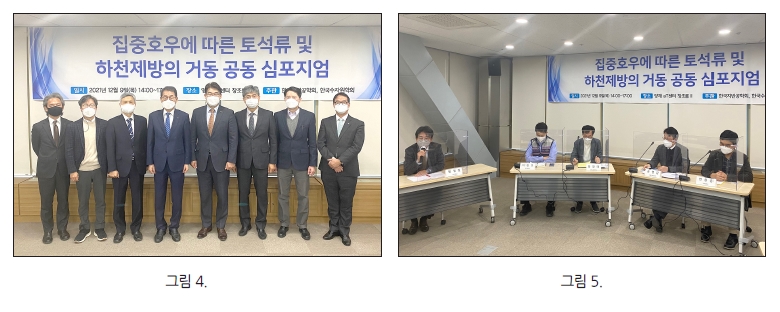
총 6건의 발표와 잠깐의 휴식에 이어 상지대학교 황영철 교수가 좌장을 맡아 홍익대학교 이승오 교수, 한국교통대학교 장창래 교수, 경북대학교 변용훈 교수, 서울기술연구원 송영갑 박사를 패널로 모시고 학문적통합 방안 및 제도적 개선을 위한 주제로 토론을 진행하였다. 장창래 교수는 두 학회의 공동 심포지엄을 통해학문적 융합이 가능할 것이라는 인상을 받았다고 소회를 밝히며 6건의 주제발표에 대한 전반적 의견을 피력하여토석류의 발생 메커니즘과 급경사 하천 및 저수지에 미치는 영향에 대한 고려까지 확산되는 것이 필요하다고하였다. 이승오 교수는 해석적 접근에 필요한 수치모델을 정교하게 발전시키고 메커니즘에 대한 정확한 이해를통해 이론을 발전시키는 노력이 중요하다고 하였다. 또한 실험과 해석의 연계를 위해 실험을 표준화하고 결과를검증하는데 있어 두 학회의 역할을 강조하였다. 송영갑 박사는 현재의 연구 방향에 공감하며 두 학회가 협력할 수있는 다양한 방안을 제시하였고 학문적 발전과 더불어 제도적 미흡한 부분을 보완해야 함에 대한 의견을제시하였다. 변용훈 교수는 참여하고 있는 연구센터를 소개하며 복합재난이 증가함에 따른 기술의 한계를 느끼고있어 융합 연구를 통해 기술 극복이 필요하다고 하였다. 이어진 질의 응답시간에는 정상섬 교수가 두 학회의교류와 연구협력의 중요성을 재차 강조하며 본 행사의 의미를 고찰하였다. 우효섭 교수는 국내사례를 참고하여해석을 위한 정확한 입력변수 도출을 위한 기초연구에 매진하고 유지관리 시스템을 구축하는 것이 필요하다는의견을 피력했다.
지반공학에 관련된 많은 현상과 지반구조물을 연구하는데 있어 관련된 타 전공분야와의 협력과 전문가 교류,금번 행사와 같은 공동 심포지엄은 지식의 경계를 허물고 외연을 넓힐 수 있는 좋은 기회였음을 모든 사람들이공감했을 것으로 보입니다. 우리 학회에서 추진한 한국수자원학회와의 공동 심포지엄에 보인 관심과 성과를바탕으로 융합연구의 실질적인 장을 만들고 앞으로 지속적인 추진이 필요합니다
윤태섭
학술전담이사
(taesup@yonsei.ac.kr)
국제학술회의 소식
International Conference & Symposium
January to June, 2022
4th African Regional Conference on Geosynthetics
o Date: February 21-24, 2022 o Venue: Cairo, Egypt
o Website: https://geoafrica2021.org/ o E-mail: info@geoafrica2021.org
16th International Conference on Geotechnical Engineering
o Date: February 23-24, 2022 o Venue: Lahore, Pakistan o Website: https://16icge.uet.edu.pk/ o E-mail: 16icge@uet.edu.pk
The 60th Rankine Lecture: The Unusual and The Unexpected in Geotechnical Engineering: Observation - Analogy - Experiment
o Date: March 16-17, 2022 o Venue: Imperial College, United Kingdom
o Website: https://www.britishgeotech.org o E-mail: bga@ice.org.uk
2nd International Conference on Energy Geotechnics
o Date: April 10-13, 2022 o Venue: San Diego, United States
o Website: https://icegt-2020.eng.ucsd.edu/home o E-mail: secretariat@icegt-2020.com
7th International Young Geotechnical Engineers Conference
o Date: April 29-May 01, 2022 o Venue: Sydney, Australia
o Website: http://icsmge2021.org/7iygec/ o E-mail: info@icsmge2021.com
20th International Conference on Soil Mechanics and Geotechnical Engineering
o Date: May 01-05, 2022 o Venue: Sydney, Australia
o Website: http://www.icsmge2021.org/ o E-mail: email@icsmge2021.com
5th International Symposium on Cone Penetration Testing(CPT’22)
o Date: June 08-10, 2022 o Venue: Bologna, Italy o agi@associazionegeotecnica.it
GEOHAZARDS 8
o Date: June 12-15, 2022 o Venue: Quebec, Canada
o Website: https://geohazards8.ca/ o E-mail: INFO@GEOHAZARDS8.CA
The 3rd International Conference on Environmental Geotechnology, Recycled Waste Materials and Sustainable Engineering
o Date: June 16-18, 2022 o Venue: Izmir, Turkey
o Website: http://www.egrwse2022.com o E-mail: egrwse2020@gmail.com
9th International Congress on Environmental Geotechnics
o Date: June 26-29, 2022 o Venue: Chania, Greece
o Website: https://www.iceg2022.org/ o E-mail: zekkos@berkeley.edu
TC204: Geotechnical Aspects of Underground Construction in Soft Ground - TC204 Cambridge 2021
o Date: June 27-29, 2022 o Venue: Cambridge, United Kingdom
o Website: https://www.is-cambridge2020.eng.cam.ac.uk/ o E-mail: me254@cam.ac.uk
5th International Conference on New Developments in Soil Mechanics and Geotechnical Engineering
o Date: June 30-July 2, 2022 o Venue: Atatürk Cultural and Congress Center, Turkey
o Website: http://zm2020.neu.edu.tr o E-mail: cavit.atalar@neu.edu.tr
July to December, 2022
4th International Symposium on Frontiers in Offshore Geotechnics
o Date: August 28-31, 2022 o Venue: University of Texas, USA
o Website: http://www.isfog2020.org o E-mail: phillip.watson@uwa.edu.au
11th International Symposium on Field Monitoring in Geomechanics
o Date: September 4-8, 2022 o Venue: Imperial College London, UK o E-mail: andrew.ridley@geo-observations.com
17th Danube - European Conference on Geotechnical Engineering
o Date: September 05-07, 2022 o Venue: Bucharest, Romania
o Website: http://www.17decge.ro o E-mail: srgf@utcb.ro
28th European Young Geotechnical Engineers Conference and Geogames
o Date: September 15-17, 2020 o Venue: Moscow, Russia
o Website: https://www.eygec28.com/ o E-mail: youngburo@gmail.com
12th International Conference on Geosynthetics
o Date: September 18-22, 2022 o Venue: Roma, Italy
o Website: http://www.12icg-roma.org o E-mail: info@12icg-roma.org
11th International Conference on Stress Wave Theory and Design and Testing Methods for Deep Foundations
o Date: September 20-23, 2022 o Venue: Rotterdam, Netherlands
o Website: https://www.kivi.nl/afdelingen/geotechniek/stress-wave-conference-2022
o E-mail: SW2022@kivi.nl
16th International Conference on Geotechnical Engineering
o Date: December 8-9, 2022 o Venue: Lahore, Pakistan o Website: https://16icge.uet.edu.pk/
o E-mail: 16icge@uet.edu.pk
January to December, 2023
17th Danube - European Conference on Geotechnical Engineering
o Date: June 7-9, 2023 o Venue: Bucharest, Romania o Website: http://www.17decge.ro o E-mail: srgf@utcb.ro
9th International Congress on Environmental Geotechnics
o Date: June 25-28, 2023 o Venue: Chania, Greece
o Website: https://www.iceg2022.org/ o E-mail: zekkos@berkeley.edu
17th Asian Regional Geotechnical Engineering Conference
o Date: August 14-18, 2023 o Venue: Nur-Sultan, Kazakhstan
o Website: https://17arc.org/ o E-mail: milanbi@mail.ru
12th International Conference on Geosynthetics
o Date: September 17-21, 2023 o Venue: Roma, Italy
o Website: http://www.12icg-roma.org o E-mail: info@12icg-roma.org
추현욱
한양대학교 건설환경공학과
(choohw@gmail.com)
해외매거진 소개
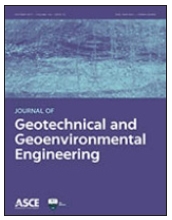
Journal of Geotechnical and Geoenvironmental Engineering
Volume 147, Issue 12 (December 2021) / https://ascelibrary.org/toc/jggefk/147/12
Technical Papers
The Role of Liquefaction on the Seismic Response of Quay Walls during the 2014 Cephalonia, Greece, Earthquakes
Georgios Zalachoris, Dimitrios Zekkos, Adda Athanasopoulos-Zekkos and Nikos Gerolymos
Validating the Generality of a Closed-Form Equation for Soil Water Isotherm
Shengmin Luo and Ning Lu
Near-Fault Forward Directivity Effect on the Estimation of Ground Motion Amplification Factors
Bo Li, Yang Lu, Zhongdong Duan and Zhen Cai
Hybrid Framework for Forecasting Circular Excavation Collapse: Combining Physics-Based and Data-Driven Modeling
Brian B. Sheil
A New Dynamic Cone Penetration Test-Based Procedure for Liquefaction Triggering Assessment of Gravelly Soils
Kyle M. Rollins, Jashod Roy, Adda Athanasopoulos-Zekkos, Dimitrios Zekkos, Sara Amoroso and Zhenzhong Cao
Key Trends Regarding the Effects of Site Geometry on Lateral Spreading Displacements
Michael Little and Ellen Rathje
Effect of Grain Crushing on the Hydraulic Conductivity of Tailings Sand
Shubjot Singh, Zygi Zurakowski, Sheng Dai and Yida Zhang
Time-Dependent Compression Behavior of Sands under Oedometric Conditions
Friedrich Levin
Role of Shear Deformability on the Response of Tunnels and Pipelines to Single and Twin Tunneling
Andrea Franza and Giulia M. B. Viggiani
Centrifuge Modeling of Cyclic Nonsymmetrical Thermally Loaded Energy Pile Groups in Clay
Charles W. W. Ng, Alireza Farivar, Sherif M. M. H. Gomaa and Fardin Jafarzadeh
Excavation Support System Design Method to Limit Damage in Adjacent Infrastructure
Jorge Romana Giraldo and L. Sebastian Bryson
Elevated Temperature Effects on Geotextile-Geomembrane Interface Shear Behavior
Tanay Karademir and J. David Frost
Liquefaction Modeling for Biocemented Calcareous Sand
Yang Xiao, Zhichao Zhang, Armin W. Stuedlein and T. Matthew Evans
Simplified Procedure to Identify the Critical State Line of Crushable Rockfills
Roberta Ventini, Stefania Lirer, Claudio Mancuso and Alessandro Flora
Prediction of Radial Consolidation Settlement with Consideration of Sampling Range Effect: Updated Observational Methods
S. G. Chung and H. J. Kweon
Implications of Interparticle Forces on Resilient and Shear Modulus of Unsaturated Compacted Kaolinite
Idil Deniz Akin, Levi S. Potter and Tuncer B. Edil
Translational Inertial Effects and Scaling Considerations for Coarse Granular Flows Impacting Landslide-Resisting Barriers
George Robert Goodwin and Clarence Edward Choi
Operational Limits of Measuring while Drilling in Florida Limestone for Geotechnical Site Characterization
Michael B. Rodgers, Michael C. McVay, David J. Horhota, Jose Hernando and Jerry M. Paris
SHANSEP-Based Interpretation of Overconsolidation Effect on Monotonic Shearing Resistance of Contractive Nonplastic Soils
Jiarui Chen and Scott M. Olson
LRFD Calibration of Internal Limit States for MSE Walls Using Steel Strip Reinforcement
Richard J. Bathurst, Nezam Bozorgzadeh and Tony Allen
Micromechanical Properties of Biocemented Shale Soils Analyzed Using Nanoindentation Test
Ming Huang, Kai Xu, Chaoshui Xu, Guixiao Jin and Shen Guo
Material Point Method for Cone Penetration in Clays
Vibhav Bisht, Rodrigo Salgado and Monica Prezzi
Effect of Loading Frequency on Volumetric Strain Accumulation and Stiffness Improvement in Sand under Drained Cyclic Direct Simple Shear Tests
Zhen-Zhen Nong and Sung-Sik Park
Machine Learning-Based Digital Integration of Geotechnical and Ultrahigh-Frequency Geophysical Data for Offshore Site Characterizations
Jinbo Chen, Marianne Vissinga, Yi Shen, Shuang Hu, Elizabeth Beal and Jason Newlin
Life Cycle Sustainability Assessment of Geotechnical Ground Improvement Methods
Alena J. Raymond, Jason T. DeJong, Alissa Kendall, J. Tanner Blackburn and Rick Deschamps
Stress Path Tests with Local Deformation Profile in Flexible Boundary Plane Strain Device
Debayan Bhattacharya and Amit Prashant
Case Studies
System Response of an Interlayered Deposit with Spatially Preferential Liquefaction Manifestations
Patrick C. Bassal and Ross W. Boulanger
A Probabilistic Geostatistics-Based Approach to Tunnel Boring Machine Cutter Tool Wear and Cutterhead Clogging Prediction
Jacob Grasmick and Michael Mooney
Technical Notes
Pore Water Pressure Development in Soft Soil due to Installation and Loading of Controlled Modulus Columns
L. Bałachowski and J. Konkol
Effect of Phase Difference on the Liquefaction Behavior of Sand in Multidirectional Simple Shear Tests
Hongxu Jin and Lin Guo

Journal of Geotechnical and Geoenvironmental Engineering
Volume 148, Issue 1 (January 2022) / https://ascelibrary.org/toc/jggefk/148/1
Technical Papers
Full-Scale Field Studies to Evaluate Deep Soil Mixing in Stabilizing Expansive Soils
Anand J. Puppala, Raja S. Madhyannapu and Soheil Nazarian
Effects of Imperfect Simple Shear Test Boundary Conditions on Monotonic and Cyclic Measurements in Sand
Daniel Wai, Mathan V. Manmatharajan and Mason Ghafghazi
Multiple Thixotropisms of Liquid Limit-Consistency Clays Unraveled by Multiscale Experimentation
Jing Peng, Shengmin Luo, Dongfang Wang, Yiming Cao, Don J. DeGroot and Guoping Zhang
Load and Resistance Factor Design for Serviceability Limit State of Laterally Loaded Drilled Shafts for Transmission Line Structures in Sands
Garam Kim and Junhwan Lee
Behavior of Piggy-Backed Drag Embedment Anchors in Marine Soils
Ying Lai, Yunhan Huang, Robert B. Gilbert and Charles P. Aubeny
Shear Strength Anisotropy of Natural Granite Residual Soil
Xinyu Liu, Xianwei Zhang, Lingwei Kong, Song Yin and Yiqing Xu
Vertical Dynamic Response of a Pile Embedded in Layered Transversely Isotropic Unsaturated Soils
Zi Ye and Zhi Yong Ai
Effect of Light Biocementation on the Liquefaction Triggering and Post-Triggering Behavior of Loose Sands
Minyong Lee, Michael G. Gomez, Maya El Kortbawi and Katerina Ziotopoulou
Unified Elastic Modulus Characteristic Curve Equation for Variably Saturated Soils
Chao Zhang, Shaojie Hu and Ning Lu
Cyclic Behavior of Saturated Clays in Plane Strain State
Tingyu Wu, Tianhao Zhang, Chuan Gu, Jun Wang, Yuanqiang Cai, Honglei Sun and Zonghao Yuan
Prediction of Pipe-Jacking Forces Using a Bayesian Updating Approach
Brian B. Sheil, Stephen K. Suryasentana, Jack O. Templeman, Bryn M. Phillips, Wen-Chieh Cheng and Limin Zhang
Improved Prediction of Peak Resistance for Spudcan Penetration in Sand Layer Overlying Clay
Jingbin Zheng, Yangbin Chen, Xiao Chen, Dong Wang and Shaodong Jing
Impact of Ground Densification on the Response of Urban Liquefiable Sites and Structures
Yu-Wei Hwang, Shideh Dashti and Peter Kirkwood
Liquefaction of Volcanic Soils: Undrained Behavior under Monotonic and Cyclic Loading
M. de Cristofaro, L. Olivares, R. P. Orense, M. S. Asadi and N. Netti
Dynamic Behavior of Single Steel-Driven Vertical and Batter Piles under Horizontal Excitations: Field Model Testing
Rohit Ralli, Bappaditya Manna and Manoj Datta
Case Studies
Nonlinear Dynamic Analyses of Perris Dam Using Transition Probability to Model Interbedded Alluvial Strata
Nicholas A. Paull, Ross W. Boulanger, Jason T. DeJong and Steven J. Friesen
Technical Notes
Energy-Based Assessment of Liquefaction Resistance of Rooted Soil
Ali Akbar Karimzadeh, Anthony Kwan Leung and Pedram Fardad Amini
Discussions and Closures
Discussion of “Case History: Failure of the Reinforced Soil Slope at Yeager Airport, Charleston, West Virginia” by Daniel R. VandenBerge, R. J. Valentine, Thomas L. Brandon, and Stephen G. Wright
James V. Hamel
Corrections
Erratum for “Excavation Support System Design Method to Limit Damage in Adjacent Infrastructure” by Jorge Romana Giraldo and L. Sebastian Bryson
L. Sebastian Bryson and Jorge Romana Giraldo
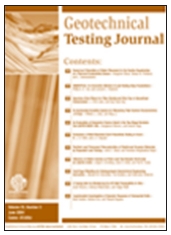
Geotechnical Testing Journal
Volume 45, Issue 1 (January 2022) / https://www.astm.org/journals/volume/listing/coden/GTJODJ/issue/1/volume/45/online-issue-date/2022-01-01+00:00:00/
Journal Papers
Determination of Dispersive Erosion Resistance in Fine-Grained Soils with Newly Developed Test Equipment
Sadettin Topçu, Hasan Tosun
A Modified Triaxial Apparatus for Soils under High-Frequency, Low-Amplitude Vibrations
Tao Xie, Peijun Guo
Seismic Centrifuge Modeling of a Gentle Slope of Layered Clay, Including a Weak Layer
Cristian Yair Soriano Camelo, Maria Cascao Ferreira de Almeida, S. P. Gopal Madabhushi, Sam A. Stanier, Marcio de Souza Soares de Almeida, Huida Liu, Ricardo Garske Borges
Field Collection of Geotechnical Measurements for Remote or Low-Cost Datalogging Requirements
Kelvin Sattler, David Elwood, Michael T. Hendry, Brian Berscheid, Bryce Marcotte, Parisa Haji Abdulrazagh, David Huntley
The Block and Cylindrical Punch Tests for Rocks: A Statistical Comparison between the Results
Fatemeh Ghasemi, Davood Fereidooni
Numerical Simulation Analysis of Real-Time High-Temperature Impact Test Technique of Rock Materials
Shi Liu, Jinyu Xu, Haoyu Wang
Predictive Model for Soil Shrinkage Characteristic Curve of High Plastic Soils
C. B. Gupt, A. Prakash, B. Hazra, S. Sreedeep
The Physical Reasons to Have Underdamped or Oscillating Variable-Head (Slug) Tests: A Review and a Clarification
Robert P. Chapuis
Borehole Magnetometry Test for Evaluating a Caisson’s Reinforced Depth: Experimental Results and Theoretical Modeling
Paulo Scarano Hemsi, Matheus Carlos de Souza Santos, Tiago de Jesus Souza, Otavio Coaracy Brasil Gandolfo, Carlos Alberto Mendonça
Calibrating Thermomechanical Triaxial Cells for Transient Thermal Loads
Sherif L. Abdelaziz, Seyed Morteza Zeinali
Reappraisal of Fall-Cone Flow Curve for Soil Plasticity Determinations
Amin Soltani, Brendan C. O’Kelly
Optical and Physical Properties of Laponite for Use as Clay Surrogate in Geotechnical Models
Rodrigo Cesar Pierozan, Abdurrahman Almikati, Gregorio Luis Silva Araujo, Jorge Gabriel Zornberg
Simulation Test System for Coal and Gas Outburst Triggered by Tunneling under Gas-Filling Condition and Its Application
Hanpeng Wang, Wei Wang, Liang Yuan, Guofeng Yu, Jing Wang, Yang Xue
Specific Surface Area by Colorimetry and Image Analysis
Marisol Salva Ramirez, J. Carlos Santamarina
A New Apparatus for Installing Distributed Optical Sensors onto Uniaxial Compression Test Specimens to Measure Full-Field Strain Responses
Shawn Hegger, Nicholas Vlachopoulos, Mark S. Diederichs
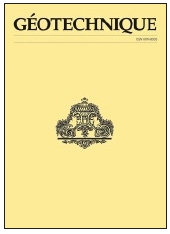
Géotechnique
Volume 71, Issue 11 (November 2021) / https://www.icevirtuallibrary.com/toc/jgeot/71/11
Articles
Editorial: linear infrastructure and slopes
Peter Bourne-Webb
Observed behaviour of old railway embankments formed of ash and dumped clay fill
Jamie R. Standing, Peter R. Vaughan, Selwyn Charles-Jones, Brian T. McGinnity
Weather-driven deterioration processes affecting the performance of embankment slopes
Ross A. Stirling, David G. Toll, Stephanie Glendinning, Peter R. Helm, Anil Yildiz, Paul N. Hughes, Jonathan D. Asquith
Hydro-mechanical reinforcement of contrasting woody species: a full-scale investigation of a field slope
David Boldrin, Anthony K. Leung, Anthony Glyn Bengough
Innovative methods of ground improvement for railway embankment peat fens foundation soil
Muhammad Umair Safdar, Maria Mavroulidou, Michael J. Gunn, Jonathan Garelick, Ian Payne, Diane Purchase
Assessment of soil spatial variability for linear infrastructure using cone penetration tests
Tom de Gast, Philip J. Vardon, Michael A. Hicks
A data-driven approach for predicting the time-dependent settlement of embankments on soft soils
James P. Doherty, M. Fraser Bransby
On the reliability assessment of a controlled dyke failure
Tom de Gast, Michael A. Hicks, Abraham P. van den Eijnden, Philip J. Vardon
Cast-iron tunnels’ tolerance to imposed longitudinal settlement curvature
Mehdi Alhaddad, Mathew J. Wilcock, Chang Ye Gue, Kenichi Soga, Michael Devriendt, Mark Dewhirst
Seismic vulnerability of circular tunnels in sand
Filomena de Silva, Stefania Fabozzi, Nikolaos Nikitas, Emilio Bilotta, Raul Fuentes

Géotechnique
Volume 71, Issue 12 (December 2021) / https://www.icevirtuallibrary.com/toc/jgeot/71/12
Articles
A model for hydraulic conductivity of compacted bentonite - inclusion of microstructure effects under confined wetting
Tian Chen, Majid Sedighi, Andrey P. Jivkov, Suresh C. Seetharam
Stability analysis of a cave excavated in granular cohesionless material
Bruna de Carvalho Faria Lima Lopes, Alessandro Tarantino
Numerical modelling of a structure with shallow strip foundation during earthquake-induced liquefaction
Konstantinos Kassas, Orestis Adamidis, Nikos Gerolymos, Ioannis Anastasopoulos
Numerical and theoretical analyses of settlements of strip shallow foundations on normally consolidated clays under partially drained conditions
Luca Flessati, Claudio di Prisco, Fabio Callea
Flume study on the effects of microbial induced calcium carbonate precipitation (MICP) on the erosional behaviour of fine sand
Alexandra Clarà Saracho, Stuart K. Haigh, M. Ehsan Jorat
Volumetric behaviour of clays under freeze-thaw cycles in a mesoscopically uniform element
Satoshi Nishimura, Shota Okajima, Bhakta Raj Joshi, Yosuke Higo, Tetsuya Tokoro
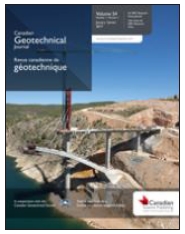
Canadian Geotechnical Journal
Volume 58, Number 11 (November 2021) / https://www.nrcresearchpress.com/toc/cgj/58/11
Articles
Hydrogeology of a complex Champlain Sea deposit (Quebec, Canada): implications for slope stability
Alexandra Germain, Nathan Young, Jean-Michel Lemieux,… and Catherine Cloutier
Generalized effective stress concept for saturated active clays
Angelica Tuttolomondo, Alessio Ferrari, and Lyesse Laloui
The mechanisms underlying long-term shaft resistance enhancement of energy pile in clays
Saeed Yazdani, Sam Helwany, and C. Guney Olgun
Selection of standard penetration test number for geotechnical investigation of a vertical cross section considering spatial variability and correlation in soil properties
Zheng Guan and Yu Wang
Smart determination of borehole number and locations for stability analysis of multi-layered slopes using multiple point statistics and information entropy
Chao Shi and Yu Wang
Interpretation of undrained shear strength observed in confined triaxial compression tests on compacted clay
C.K. Wong, M.C.H. Lun, and R.C.K. Wong
A non-associative macroelement model for vertical plate anchors in clay
Anderson Peccin da Silva, Andrea Diambra, Dimitris Karamitros, and Shiao Huey Chow
Three-dimensional cyclic behavior of saturated clays: comparison between undrained and partly drained conditions
Yanlin Zhang, Chuan Gu, Jun Wang, and Yuanqiang Cai
Material point method (MPM) hydro-mechanical modelling of flows impacting rigid walls
Sabatino Cuomo, Angela Di Perna, and Mario Martinelli
In situ desaturation tests by electrolysis for liquefaction mitigation
Runze Chen, Yumin Chen, Hanlong Liu, Kunxian Zhang, Ying Zhou, Shengming Xu, and Kang Wu
Thermo-mechanical behavior of a full-scale energy pile equipped with a spiral pipe configuration
Di Wu, Hanlong Liu, Gangqiang Kong, and Alessandro F. Rotta Loria
Impact of scour on lateral resistance of wind turbine monopiles: an experimental study
Q. Li, A. Askarinejad, and K. Gavin
Notes
Flow liquefaction potential of loose sand: stress path envelope and energy-based evaluation
K. Pan, Z.X. Yang, and Y.Q. Cai
Correction
Correction: Laboratory study on subgrade fluidization under undrained cyclic triaxial loading
Buddhima Indraratna, Mandeep Singh, Thanh Trung Nguyen, Serge Leroueil, Aruni Abeywickrama, Richard Kelly, and Tim Neville

Canadian Geotechnical Journal
Volume 58, Number 12 (December 2021) / https://www.nrcresearchpress.com/toc/cgj/58/12
Articles
Model tests on biogrouted granular columns in soft soil
Aamir Mahawish, Abdelmalek Bouazza, and Will P. Gates
A hybrid GMDH neural network and logistic regression framework for state parameter-based liquefaction evaluation
Wei Duan, Surya Sarat Chandra Congress, Guojun Cai, Songyu Liu, Xiaoqiang Dong, Ruifeng Chen, and Xuening Liu
Relationship between monotonic and cyclic behavior of saturated soft clay in undrained triaxial compression tests
Tingyu Wu, Jie Han, Yuanqiang Cai, Lin Guo, and Jun Wang
Large-scale model tests of a single pile and two-pile groups for an offshore platform in sand
Aligi Foglia, Khalid Abdel-Rahman, Elmar Wisotzki, Tulio Quiroz, and Martin Achmus
Development of a poly-axial platen for testing true-triaxial behavior of rocks
Prasoon Garg, Bhardwaj Pandit, Brijes Mishra, and G.L. Sivakumar Babu
Measured pipe stresses on gas pipelines in landslide areas
Nelson J. Ferreira and James A. Blatz
Driven cast-in-situ pile capacity: insights from dynamic and static load testing
Kevin N. Flynn and Bryan A. McCabe
Relationship between texture of polypropylene coatings and interface friction for sand at low stress levels
Lawrence W. de Leeuw, Matthew S. Dietz, Henry Milewski, George Mylonakis, and Andrea Diambra
A risk assessment tool for tailings storage facilities
Karen M. Chovan, Michel R. Julien, Edouardine-Pascale Ingabire, Michael James, Edouard Masengo, Thomas Lépine, and Pascal Lavoie
Monotonic and cyclic behaviour of root-reinforced sand
Ali Akbar Karimzadeh, Anthony Kwan Leung, Saied Hosseinpour, Zhaoyi Wu, and Pedram Fardad Amini
Study on horizontal bearing characteristics of pile foundations in coral sand
Chunyan Wang, Hanlong Liu, Xuanming Ding, Chenglong Wang, and Qiang Ou
Effects of interactions between transient granular flows and macroscopically rough beds and their implications for bulk flow dynamics
C.E. Choi and G.R. Goodwin
Discussion
Discussion of “Evaluation of installation effects on set-up of field displacement piles in sand”
Gholamreza Mesri and Thierno Kane
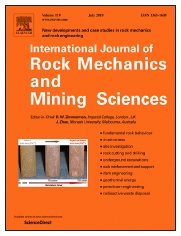
International Journal of Rock Mechanics and Mining Sciences
Volume 148 (December 2021) / https://www.sciencedirect.com/journal/international-journal-of-rock-mechanics-and-mining-sciences/vol/148/suppl/C
Research Articles
Anisotropic deformability and strength of slate from NW-Spain
L.R. Alejano, M.A. Gonzalez-Fernandez, X. Estévez-Ventosa, Fei Song, ... J. Alvarellos
Investigation of the efficiency of longwall top coal caving method applied by forming a face in horizontal thickness of the seam in steeply inclined thick coal seams by using a physical model
Arif Celik, Yılmaz Özçelik
Fracturing mechanisms and deformation characteristics of rock surrounding the gate during gob-side entry retention through roof pre-fracturing
Pengfei Guo, Yadi Yuan, Kengkeng Ye, Dingjie Sun
Experimental and numerical (EFG method) studies on sedimentary rock under varied salinity conditions
P. Dinesh, P.G. Ranjith, M.R. Behera, N. Muthu
Dispersive seismic waves in a coal seam around the roadway in the presence of excavation damaged zone
Rafał Czarny, Michał Malinowski, Michał Chamarczuk, Mateusz Cwiekała, ... Przemysław Sierodzki
A multifrequency ultrasonic approach to extracting static modulus and damage characteristics of rock
Yuliang Zhang, Gao-Feng Zhao, Xindong Wei, Haibo Li
A new integral equation method for calculating interacting stress-intensity factors of multiple holed-cracked anisotropic rock under both far-field and arbitrary surface stresses
Wei Yi, Qiu-hua Rao, Dong-liang Sun, Qing-qing Shen, Jie Zhang
Improving local mean stress estimation using Bayesian hierarchical modelling
Yu Feng, Ke Gao, Arnaud Mignan, Jiawei Li
New criterion for the spalling failure of deep rock engineering based on energy release
Peng Xiao, Diyuan Li, Guoyan Zhao, Huanxin Liu
Experimental study on wave propagation through granite after high-temperature treatment
L.F. Fan, K.C. Yang, M. Wang, L.J. Wang, Z.J. Wu
Improved empirical hard rock pillar strength predictions using unconfined compressive strength as a proxy for brittleness
G. Walton, S. Sinha
Laboratory characterization of cyclic hydraulic fracturing for deep shale application in Southwest China
Yunzhong Jia, Zhaohui Lu, Qiquan Xiong, Jesse C. Hampton, ... Pei He
Optimizing well construction by establishing overpressure mechanism in Panna Formation, Western Offshore Basin, India
Rahul Talreja, Rajeev Kumar, Prince Kumar, Jayant Bhagat, ... Amit Kumar Singh
Anisotropic mechanical behaviour of columnar jointed rock masses subjected to cyclic loading: An experimental investigation
Tao Zhang, Weiya Xu, Huanling Wang, RuBin Wang, ... MingTao Hu
Impact of time-dependent deformation on geomechanical risk for geologic carbon storage
Ting Bao, Jeff Burghardt, Varun Gupta, Mark White
Hard Rock Fragmentation in Percussion Drilling Considering Confining Pressure: Insights from an Experimental Study
Yanliang Li, Jianming Peng, Pengyu Zhang, Chaoyang Huang
Combined numerical and experimental studies on the dynamic and quasi-static failure modes of brittle rock
Chunjiang Zou, Huanqiang Li
Modeling the behavior of a coal pillar rib using Bonded Block Models with emphasis on ground-support interaction
Sankhaneel Sinha, Gabriel Walton
Monitoring and analysis of ground movement from multi-seam mining
Qingdong Qu, Hua Guo, Manoj Khanal
Expanding application of the voussoir beam analog to horizontally bedded and passively bolted flat-roof excavations using the discrete element method
Rami Abousleiman, Sankhaneel Sinha, Gabriel Walton
Numerical modelling of incipient motion of fracture infillings
Penghua Teng, Suihan Zhang, Fredrik Johansson
Loading-unloading behavior of a clayey rock under thermo-hydro-mechanical conditions
Hongdan Yu, Weizhong Chen, Zhe Gong, Xianjun Tan, Diansen Yang
A grain texture model to investigate effects of grain shape and orientation on macro-mechanical behavior of crystalline rock
Xianyu Zhao, Derek Elsworth, Yunlong He, Wanrui Hu, Tao Wang
Earth tides and seismic activity in deep coal mining
Sławomir Siwek
An Uzawa-type augmented Lagrangian numerical manifold method for frictional discontinuities in rock masses
Yongtao Yang, Wenan Wu, Hong Zheng
Dynamic failure behavior of Jinping marble under various preloading conditions corresponding to different depths
Anlin Zhang, Heping Xie, Ru Zhang, Li Ren, ... Qiang Tan
Thermoplastic cohesive fracturing model of thermally-treated granite
Yuekun Xing, Bingxiang Huang
Effect of concave terrain on explosion-induced ground motion
Zhengliang Li, Jianchun Li, Haibo Li
Bayesian inference of rock strength anisotropy: Uncertainty analysis of the Hoek-Brown failure criterion
Guilherme J.C. Gomes, John H. Forero, Euripedes A. Vargas, Jasper A. Vrugt
An overview on flooding induced uplift for abandoned coal mines
Jian Zhao, Heinz Konietzky
Experimental study on resin-anchored bolt concentricity including a device for more consistent bolt centering
Deyin He, Shaowei Liu, Mengxiong Fu, Bo Peng, Yaofei Ren
Numerical simulation of fracture propagation in freezing rocks using the extended finite element method (XFEM)
Yun Zhou, Wei Ma, Xianjun Tan, Weizhong Chen, ... Fei Xu
Dynamic and static electrical characteristics of micro-surface of rocks by coupled use of Atomic Force Microscope and micro-loading device
Huifang Liu, Zhenlei Li, Xueqiu He, Linbing Wang, ... Weixiang Wang
Assessing the conditions at the boundary of excavations in bedded or foliated rocks
Ross Seedsman
Development of a 3-D confinement-dependent dilation model for brittle rocks; part 2, formulation and parameterization based on the Cartesian plastic strain increments ratios approach
M. Rahjoo, E. Eberhardt
Hydro-mechanical modelling of gas transport in clayey host rocks for nuclear waste repositories
Jianxiong Yang, Mamadou Fall
Uplift of the surface of the earth above abandoned coal mines. Part A: Analysis of satellite data related to the movement of the surface
Andre Vervoort
Uplift of the surface of the earth above abandoned coal mines. Part B: Framework to understand and explain uplift
Andre Vervoort
Technical Notes
A numerical integrated approach for the estimation of the uniaxial compression strength of rock from point load tests
Yi-Ming Li, Gao-Feng Zhao
Formulation, calibration, and applications of disk-based discontinuous deformation analysis for rock failure simulation
Kaiyu Zhang, Feng Liu, Kaiwen Xia
Limit equilibrium analysis on the stability of rock wedges with linear and nonlinear strength criteria
Dong-ping Deng
Development of empirical model for strength estimation of irregular-shaped-heightened-rib/snook for mechanised depillaring
Ashok Kumar, Dheeraj Kumar, Arun Kumar Singh, Sahendra Ram, Rakesh Kumar
Rockburst and microseismicity characteristics in the Qinling water conveyance tunnel of the Hanjiang-to-Weihe River Diversion Project
Fei Liu, Chun'an Tang, Yongjun Zhang, Tianhui Ma
Failure characterization of Longmaxi shale under direct shear mode loadings
H.J. Lu, H.P. Xie, Y. Luo, L. Ren, ... M.Q. Yang

International Journal of Rock Mechanics and Mining Sciences
Volume 149 (January 2022) / https://www.sciencedirect.com/journal/international-journal-of-rock-mechanics-and-mining-sciences/vol/149/suppl/C
Research Articles
Dynamic photoelastic experimental study on the influence of joint surface geometrical property on wave propagation and stress disturbance
Siwei Wang, Jianchun Li, Xing Li, Lei He
Rock mass characteristics model for TBM penetration rate prediction- an updated version
Qiuming Gong, Hongyi Xu, Jianwei Lu, Fan Wu, ... Lijun Yin
Discing behavior and mechanism of cores extracted from Songke-2 well at depths below 4,500 m
Gao Mingzhong, Hao Haichun, Xue Shouning, Lu Tong, ... Xie Heping
Semi-automatic calculation of joint trace length from digital images based on deep learning and data structuring techniques
Yong-Ki Lee, Jineon Kim, Chae-Soon Choi, Jae-Joon Song
Micro-mechanism of brittle creep in saturated sandstone and its mechanical behavior after creep damage
Zhaofei Chu, Zhijun Wu, Zhiyang Wang, Lei Weng, ... Lifeng Fan
Characterizing thermal damage of diorite treated by an open-ended microwave antenna
Zhongjun Ma, Yanlong Zheng, Jianchun Li, Xiaobao Zhao, ... Huanyu Fu
A FDEM-based 2D coupled thermal-hydro-mechanical model for multiphysical simulation of rock fracturing
Chengzeng Yan, Xin Xie, Yuhang Ren, Wenhui Ke, Gang Wang
Analytic approximant of elastic stress around noncircular shallow-buried tunnels under general loading conditions
Ping Wu, Dayong Zhu
Progressive damage and fracture of biaxially-confined anisotropic coal under repeated impact loads
J. Li, H.C. Wang, Q.B. Zhang
A systematic methodology to calibrate wellbore failure models, estimate the in-situ stress tensor and evaluate wellbore cross-sectional geometry
Asmae Dahrabou, Benoît Valley, Peter Meier, Philip Brunner, Andrés Alcolea
Technical Notes
Excavation rate “predicting while tunnelling” for double shield TBMs in moderate strength poor to good quality rocks
Baogang Mu, Wenkun Yang, Yanlong Zheng, Jianchun Li
Measurement of ejection velocity of rock fragments under dynamic compression and insight into energy partitioning
Haozhe Xing, Mingyang Wang, Minghe Ju, Jianchun Li, Xiaofeng Li
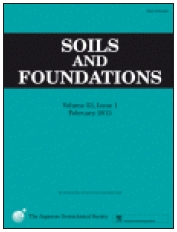
Soils and Foundations
Volume 61, Issue 6 (December 2021) / https://www.sciencedirect.com/journal/soils-and-foundations/vol/61/issue/6
Technical Paper
Influence of acidic environment and temperature on mechanical behavior of cement-treated Masado and numerical modeling with a thermoelasto-viscoplastic model
Peng Peng, Hiromasa Iwai, Ittetsu Ohara, Tomoya Iwata, Feng Zhang
Face failure in cobble-rich soil: Numerical and experimental approaches on 1g EPB reduced scale model
Xiongyu Hu, Chuan He, Gabriel Walton, Yong Fan
Mid-scale biocemented soil columns via enzyme-induced carbonate precipitation(EICP)
Kimberly K. Martin, Hamed Khodadadi Tirkolaei, Edward Kavazanjian
One-dimensional consolidation of unsaturated soils considering self-weight: Semi-analytical solutions
Lei Wang, Annan Zhou, Yongfu Xu, Xiaohe Xia
Evaluation of post-liquefaction volumetric strain of reconstituted samples based on soil compressibility
Jongkwan Kim, Motoki Kazama, Tadashi Kawai
A new approach for evaluating lateral resistance of railway ballast associated with extended sleeper spacing
Emiri Koyama, Kazuki Ito, Kimitoshi Hayano, Yoshitsugu Momoya
Testing and modelling total suction effects on compressibility and creep of crushable granular material
Rodrigo Osses, Kasra Majdanishabestari, Carlos Ovalle, Jubert Pineda
Strength and stiffness parameters for hardening soil model of rockfill materials
Raksiri Sukkarak, Suched Likitlersuang, Pornkasem Jongpradist, Pitthaya Jamsawang
Effects of water content and interface roughness on the shear strength of silt-cement mortar interface
Mengyao Li, Yonghui Li, Md. Rajedul Islam
Influence of prefabricated vertical drains spacing on FeCl3-vacuum consolidation of a landfill sludge
Xudong Zhang, Yajun Wu, Yitian Lu, Guang Chen, ... Peng Ye
3D analysis of the 174-m high Quxue asphalt-core rockfill dam in a narrow canyon
Tao Qiu, Weibiao Wang, Kaare Hoeg, Shan Feng, Ran Zhao
Experimental study on suffusion under multiple seepages and its impact on undrained mechanical responses of gap-graded soil
Jitrakon Prasomsri, Akihiro Takahashi
Influence of longitudinal structural connectivity on seismic performance of three-hinged precast arch culverts
Yuusuke Miyazaki, Yasuo Sawamura, Kiyoshi Kishida, Makoto Kimura
Technical Notes
Evaluation of CO2 captured in alkaline construction sludge associated with pH neutralization
Kouki Inasaka, Nguyen Duc Trung, Kimitoshi Hayano, Hiromoto Yamauchi
Investigation of the ultimate particle size distribution of a carbonate sand
Kewei Fan, Yanhao Zheng, Beatrice Anne Baudet, Yi Pik Helen Cheng
ISSMGE TC103
Numerical modelling of large deformation problems in geotechnical engineering: A state-of-the-art review
Charles E. Augarde, Seung Jae Lee, Dimitrios Loukidis
추현욱
한양대학교 건설환경공학과
(choohw@gmail.com)
논문집 개요 소개
논문집 개요 소개 | 2021년 10월 제 37권 10호
압축 벤토나이트 완충재의 역학 물성 평가
윤 석 (정회원, 한국원자력연구원 저장처분기술관리부 책임연구원)
홍창호 (정회원, 한국원자력연구원 처분성능실증연구부 선임연구원)
김태현 (정회원, 한국원자력연구원 처분성능실증연구부 선임연구원, kth@kaeri.re.kr)
김진섭 (정회원, 한국원자력연구원 처분성능실증연구부 책임연구원)
압축 벤토나이트 완충재는 원자력발전소에서 발생하는 고준위폐기물을 처리하기 위한 공학적방벽시스템의 가장 중요한 요소 중 하나이다. 압축 벤토나이트 완충재는 외부 하중이나 지하수 침투로부터 처분 용기를 보호하기에, 열-수리-역학적인 요구 조건을 충족하여야 한다. 이러한 완충재의 열-수리 물성에 관한 연구는 많이 진행되어 왔지만, 역학 물성 규명에 관한 연구는 많이 부족한 실정이다. 이러한 이유로, 본 연구에서는 건조밀도와 함수비에 따른 다양한 국내 압축 벤토나이트 시료를 조성하여 이에 대한 일축압축강도시험을 실시하였으며, 일축압축강도, 탄성계수, 그리고 포아송비를 도출하였다. 압축 벤토나이트의 일축압축강도와 탄성계수는 건조밀도에 따라 증가하였으며, 포아송비는 건조밀도가 증가할수록 약간 감소하는 것으로 나타났다. 일축압축강도, 탄성계수 및 포아송비는 건조밀도와 큰 상관관계를 보였으나, 함수비와는 특별한 상관성을 나타내지는 않았다.
트라우즐 연주시험 및 고속 3차원 이미지영상상관 기법을 이용한 전색재 별 발파효과에 대한 연구
고영훈 (정회원, 한국건설기술연구원 지반연구본부 박사후연구원)
서승환 (정회원, 한국건설기술연구원 지반연구본부 전임연구원)
김 식 (비회원, ㈜석성발파건설 상무이사)
정영준 (비회원, ㈜석성발파건설 대표이사)
정문경 (정회원, 한국건설기술연구원 지반연구본부 선임연구위원, mkchung@kict.re.kr)
트라우즐 연주시험은 화약의 발파성능을 검증하기 위해서 널리 사용되는 시험방법 중 하나이다. 위력이 검증된 폭약을 연주블록의 발파공에 장약 및 전색하여 폭발시킨 후 발파공의 체적변화를 통해 화약의 위력 또는 전색효과 등을 측정하는 방법이라 할 수 있다. 본 연구에서는 발파 시 전색물에 따른 전색효과를 서로 비교하기 위하여 트라우즐 연주시험 및 3차원 고속카메라를 이용한 이미지영상상관기법을 도입하여 발파실험을 수행하였다. 실험에 사용된 폭약은 산업용 에멀젼 폭약을 적용하였고, 전색재료는 모래 및 잔골재를 사용하였다. 트라우즐 연주시험 및 수치해석을 통한 비교에서 표준사보다 잔골재 전색의 경우가 연주블록의 확장이 크게 나타났으며, 3D-DIC 시스템에서도 잔골재 전색의 경우가 모래전색보다 직경변화와 표면변형률 모두 높은 수치를 보였다.
열 사이펀 성능에 따른 동상민감성 지반의 거동 비교
박동수 (정회원, 한국해양대학교 해양과학기술융합학과 박사과정)
신문범 (정회원, 한국해양대학교 해양과학기술융합학과 박사과정)
서영교 (정회원, 한국해양대학교 해양공학과 교수 및 해양과학기술융합학과 겸임교수, yseo@kmou.ac.kr)
동상민감성 지반의 융기 및 침하 방지를 위한 공법을 지반 안정화 공법이라고 하며 열 사이펀은 대표적인 지반 안정화 공법 중 하나이다. 열 사이펀은 최근 간편한 해석모델 개발과 더불어 열 해석이 진행되었지만, 이에 따른 동상민감성 지반의 열적 거동을 고려하지 않았다. 따라서 본 연구는 열 사이펀의 성능에 따른 지반의 온도 변화를 위한 열 해석과 이에 따른 지반의 거동을 예측하기 위한 구조해석을 동시에 수행하기 위해 ABAQUS 내부 사용자 서브루틴을 사용하여 열 사이펀을 적용한 TM(Thermo-Mechanical) 모델을 개발하여 열 사이펀의 성능에 따른 지반 융기 억제성능을 확인하였다. 해석결과 열 사이펀의 성능 증가에 따라 지반의 최종 융기가 감소하였으며 냉매 충전율 25%, 50% 그리고 100%의 열 사이펀 적용 시 각각 5.5%, 14.4%, 21% 융기 억제성능을 나타내었다.
취약도 곡선에 의한 수리구조물 하부 지반의 확률론적 침투 안정성 평가
조성은 (정회원, 한경대학교 건설환경공학부 교수, drsecho@hanmail.net)
본 연구에서는 침투조절을 위하여 댐이나 보와 같은 수리구조물의 기초지반에 설치되는 차수벽체 형태에 따른 포화 침투거동의 확률론적 거동을 연구하였다. 이를 위해 투수계수의 불확실성과 공간적 변동성을 고려한 정상상태 흐름의 유한요소해석에 기반을 둔 Monte Carlo 시뮬레이션을 수행하였다. Monte Carlo 시뮬레이션의 결과로부터 평가된 지반의 침투거동에 대한 확률분포로부터 수위 변동에 따른 파괴확률을 구함으로써 취약도 곡선을 작성하였다. 취약도 곡선은 침투로 인한 수리구조물과 기초지반의 안정성을 검토하기 위하여 기초지반을 통한 침투유량, 구조물에 작용하는 양압력, 하류 유출면에서의 유출동수경사에 대하여 작성하였다. 생성된 취약도 곡선들로부터 차수벽체 설치 형태가 수위 상승 시 수리구조물과 기초지반의 안정에 대한 신뢰성에 미치는 영향을 연구하였다.
점토지반 병설쉴드터널에서 후행터널 굴착에 의한 비대칭 침하형상 연구
안창윤 (정회원, 한양대학교 건설환경공학과 박사과정, 현대산업개발㈜ 건설관리본부, cyahn78@gmail.com)
박두희 (정회원, 한양대학교 건설환경공학과 교수)
쉴드TBM의 제작기술 발전과 시공경험 축적으로, 쉴드터널은 전력, 통신 및 상하수도와 같은 소구경 터널에서 도로 및 철도와 같은 대구경 터널로 확대되고 있으며, 그에 따라 병설쉴드터널의 적용도 증가하고 있다. Peck(1969)에 의해 연약지반에서 단선쉴드터널의 지표침하형상이 Gaussian distribution으로 표현될 수 있음이 제시된 이후, 현장계측, 실내모형실험 및 수치해석 등의 방법을 통해 많은 연구에서 이의 적정성이 확인되었다. 본 연구는 현장 계측된 병설쉴드터널의 지표침하로부터 후행 터널(2nd tunnel)에 의한 추가 지표침하 형상을 표현하기 위해 침하형상의 좌?우측에 Gaussian curve를 각각 적용함으로써, 침하형상을 보다 정확히 표현할 수 있음을 알 수 있었다.
터널 라이닝 공동에 대한 GPR 신호 특성 분석을 위한 수치해석 연구
고규현 (정회원, 금오공과대학교 토목공학과 조교수)
이성진 (정회원, 한국철도기술연구원 첨단인프라융합연구실 책임연구원, geolsj@krri.re.kr)
노후화된 터널 구조물의 라이닝 내부 및 배면에 존재하는 공동은 다양한 원인에 의해 발생되며 대부분의 경우 육안검사가 불가능한 곳에 존재하기 때문에 이에 대한 점검이 쉽지 않다. 최근에는 지반탐사레이더와 같은 비파괴시험 등을 이용하여 터널 라이닝과 배면에 대한 상태를 평가하는 시도가 이루어지고 있으며, 이와 관련된 다양한 모형시험 및 해석연구가 수행되고 있다. 본 연구에서는 gprMax 소프트웨어를 이용하여 터널 라이닝 모형 시험체 조건에 대한 GPR 신호특성을 시각화하여 분석하였고, 이를 모형체 시험 결과와 비교하였다. 모형체 시험에 적용된 GPR 해석모델은 터널 라이닝 및 내부 공동 등 매질 변화에 대한 전자기파 신호변화를 합리적으로 모사하였다. 검증된 수치해석모델을 이용하여 터널 라이닝의 두께, 내부의 공동 존재와 규모, 방수막의 영향, 주파수대역의 영향 등을 평가하기 위한 GPR 분석 기법 개발에 필요한 데이터를 확보하였다.
도심지 지중매설물 밀집도와 이력지반함몰의 상관성 분석을 위한 최적화 알고리즘에 관한 연구
최창호 (정회원, 한국건설기술연구원 지반연구본부 연구위원, chchoi@kict.re.kr)
김진영 (정회원, 한국건설기술연구원 지반연구본부 수석연구원)
백성하 (정회원, 한국건설기술연구원 지반연구본부 수석연구원)
강재모 (정회원, 한국건설기술연구원 지반연구본부 수석연구원)
도심지에서 발생하는 지반함몰의 위험도를 분석하고 예측 및 예방하기 위한 연구가 다양하게 진행되었다. 기존의 연구 중에 지하매설물의 밀도(즉, 대상 공간 주변 지중에 설치된 매설물의 공간적인 물량)와 지반함몰 발생의 상관성을 활용한 위험도 분석 연구는 미비하다. 본 논문에서는 GIS기반 공간정보 데이터를 활용하여 지하에 설치되어 있는 매설물의 선형밀도(line density)를 분석하고, 이를 이력지반함몰 발생 현황과 연계하는 연구를 수행하였다. 분석 대상 지역에 대하여 2010~2015년 사이에 발생한 29개 이력지반함몰과 6종 지하매설물 선형밀도의 상관관계를 극대화하기 위한 최적화 알고리즘을 개발하였고, 보편적인 분석을 위해 정규선형밀도의 개념을 제안하였다. 분석 대상 지역의 정규선형밀도를 5개 등급(1등급 최저, 5등급 최고)으로 구분하였으며, 최적화 알고리즘을 적용할 경우 이력지반함몰 위치에서 정규선형밀도가 4등급 이상인 경우가 약 80%이상으로 나타났다. 제안된 최적화 알고리즘을 활용하여 지하매설물의 밀집도 분석 결과를 지반함몰 위험도 분석에 적용할 수 있을 것으로 판단된다.
논문집 개요 소개 | 2021년 11월 제 37권 11호
수치해석 결과 분석을 통한 다양한 말뚝 선단하부의 지반조건에 따른 대구경현장타설말뚝의 지지력 거동에 관한 연구
김채민 (정회원, 경성대학교 토목공학과 강사)
윤도균 (정회원, 경성대학교 대학원 건설환경도시공학과 박사과정)
최용규 (정회원, 경성대학교 공과대학 토목공학과, ykchoi@ks.ac.kr)
본 연구에서는 현장타설말뚝에서 실시된 양방향말뚝재하시험 자료에 대하여 역해석을 실시하였다. 그리고 실트질 점토, 실트질 모래, 모래질 실트, 모래질 자갈, 풍화암, 연암의 다양한 선단지반에 지지된 대구경 현장타설 말뚝에 대하여 수치해석을 실시하여 지지력을 분석하였다. 지지력 분석은 P-S 방법, Davisson 방법, 25.4mm 허용침하량을 이용하여 산정하였다. 3가지 방법으로 분석한 최소 허용지지력은 19.64MN~24.96MN으로 나타났다. 이때, 선단지지력은 두부재하하중의 2%~12%를 분담하였으며, 주면마찰력은 두부재하하중의 88% ~ 98%를 분담하였다. 선단 지반의 강도가 클수록 허용지지력이 증가하는 것으로 나타났다. 그러나 최대 허용지지력과 최소 허용지지력의 차이는 5.32MN로 선단 지반종류에 따른 허용지지력의 증가는 27%에 불과하였다.
실내시험 시 재하속도가 미고결 및 고결 모래의 강도에 미치는 영향
문홍득 (정회원, 경상국립대학교 건설환경공과대학 토목공학과 교수)
김정숙 (비회원, 경북대학교 공과대학 건설환경에너지공학부 석사과정)
우승욱 (비회원, 경북대학교 공과대학 건설환경에너지공학부 박사과정)
Tran, Dong-Kiem-Lam (비회원, 경북대학교 공과대학 건설환경에너지공학부 박사과정)
박성식 (정회원, 경북대학교 공과대학 토목공학과 교수, sungpark@knu.ac.kr)
본 논문에서는 실내시험 시 재하속도가 미고결 모래의 내부 마찰각 그리고 고결모래의 일축압축강도에 미치는 영향에 대해 연구하였다. 건조상태의 주문진모래를 상대밀도 40%로 느슨하거나, 60%로 중간 정도 및 80%로 조밀한 상태로 제작한 다음 0.32, 0.64, 2.54mm/min의 재하속도로 직접전단시험을 실시하였다. 또한, 주문진모래에 시멘트 8% 및 12%로 다짐한 직경 50mm, 높이 100mm의 고결 공시체를 일축압축시험 시 0.1, 0.5, 1, 5, 10%/min의 재하속도로 압축하였다. 모래의 고결 여부나 정도에 관계없이 재하속도가 증가할수록 내부 마찰각과 일축압축강도는 증가하는 경향을 보였다. 미고결 모래의 경우 재하속도가 증가할수록 최대 4° 까지 내부 마찰각이 증가하였다. 고결 모래의 경우도 일반적으로 재하속도에 따라 일축압축강도가 증가하였으나, 표준 재하속도인 1%/min를 기준으로 증가하는 경향이 감소하였다. 또한, 개별요소법을 이용하여 고결 모래의 재하속도에 따른 균열 발생 및 발달 과정을 분석하였으며, 해석결과 또한 재하속도가 증가함에 따라 강도가 증가하는 경향을 보였으며 강도가 증가할수록 균열이 뚜렷하게 발달하였다.
원심모형실험을 활용한 선단확장형 마이크로파일의 설치 메커니즘 평가
김재현 (정회원, 강원대학교 문화예술?공과대학 건축토목환경공학부 토목공학전공, 조교수)
김석중 (정회원, 한국건설기술연구원 기획조정본부, 수석연구원)
한진태 (정회원, 한국건설기술연구원 지반연구본부, 연구위원)
이석형 (정회원, 한국건설기술연구원 지반연구본부, 박사후연구원, seokhyung@kict.re.kr)
마이크로파일은 기초의 지지력 증대와 침하량 저감을 위해 건설분야에서 널리 활용되는 기초이다. 본 기초는 낮은 건설비용, 단순한 시공 프로세스와 비교적 작은 장비로 시공이 가능하다는 장점이 있다. 최근 지지력을 효과적으로 증대시킬 수 있는 선단확장형 마이크로파일이 개발되었다. 본 기초는 수직하중이 재하될 때 마이크로파일 선단부에 설치된 지압구가 팽창하여 주변지반에 작용하는 수평토압을 증가시키며, 이로 인해 기초의 지지력이 향상된다. 하지만, 현재까지 지압구 확장 메커니즘과 지지력 증대효과가 실험적으로 명확히 검증되지 않았다. 따라서, 본 연구에서는 지압구의 설치효과를 검증하기 위해 원심모형실험이 수행되었다. 이를 위해, 모래지반과 풍화암으로 구성된 지반을 각각 조성하고, 실제 선단확장형 마이크로파일에 대한 하중재하실험을 수행하였으며, 기초에 수직하중이 작용할 때 지압구 주변에 설치된 토압계를 통해 지압구의 팽창거동을 관찰하였다. 실험 결과, 30kN의 하중이 기초에 작용할 때 모래지반에서는 수직토압대비 수평토압의 증가량(?σh/?σv)이 0.4 - 0.58의 범위를 보였으며, 풍화암지반에서는 ?σh/?σv = 0.19로 확인되었다. 본 결과를 통해 지압구 확장에 따른 수평토압 증가가 실험적으로 확인되었으며, 이로 인해 마이크로파일의 지지력이 증가될 것으로 판단된다.
교량 우물통 기초의 세굴피해 평가를 위한 고유진동수 측
Nguyen, Quang-Thien-Buu (비회원, 서울대학교 건설환경공학부 박사과정)
고석준 (비회원, 서울대학교 건설환경공학부 석사과정)
정경자 (정회원, 한국도로공사 수석연구원)
이주형 (정회원, 한국건설기술연구원 지반연구본부 연구위원)
유민택 (정회원, 한국철도기술연구원 선임연구원)
김성렬 (정회원, 서울대학교 건설환경공학부 부교수, sungryul@snu.ac.kr)
하천의 세굴은 교각 주변의 흙을 침식시켜 교각의 횡방향 지지력을 저감시키고 구조물의 건전도를 저하시키게 된다. 본 연구에서는 세굴이 구조물의 건전도에 미치는 영향을 살펴보고자 주변지반의 굴착에 따른 교각의 고유진동수 측정실험을 수행하였다. 폐교예정인 만경강교의 우물통기초 교각에서 충격진동시험을 수행하였다. 교각의 상단, 중앙, 하단에 가속도계를 부착하고 세 지점을 타격하여 가속도를 계측하였다. 실험 결과, 타격위치에 따른 가속도 측정값 중 상단타격이 일관되고 합리적인 가속도 결과를 보여주었다. 계측된 가속도는 고속 푸리에 변환(FFT)을 통하여 주파수 영역으로 변환되었고, 이를 이용하여 고유진동수를 측정하였다. 또한, 세굴이 교각의 고유진동수 변화에 미치는 영향을 분석하기 위하여 교각 주변 지반을 굴착하면서 고유진동수의 변화를 측정하였다. 그 결과, 굴착 깊이에 따라 고유 진동수가 감소하는 경향을 보여주었지만, 우물통 기초형식이 큰 강성을 가지고 있어 그 감소폭은 작은 것으로 나타났다.
동적 응답 분석을 통한 철도교량 하부구조의 피해평가기법연구
이명재 (정회원, 한국철도기술연구원 철도구조연구실 선임연구원)
이일화 (정회원, 한국철도기술연구원 첨단인프라융합연구실 책임연구원)
유민택 (정회원, 한국철도기술연구원 철도구조연구실 선임연구원, thezes@krri.re.kr)
본 연구는 교각의 고유진동수를 통해 교각에 인접한 지반의 세굴 발생여부를 판단하기 위해 축소모형교각을 제작하여 충격하중을 이용해 일련의 비파괴 실험을 수행하였다. 축소모형교각은 길이별로 총 3개의 교각을 제작하였으며, 관입깊이는 0.35m로 일정하게 지반에 관입하였다. 세굴은 크게 2가지로 교각의 측면세굴과 기초바닥세굴을 모사하였으며, 0.05m씩 굴착하여 단계별로 step 0에서 step 12 까지 총 13단계의 실험을 모든 교각에 대해 수행하였다. 또한 고유진동수를 도출하기 위해 모형교각에 총 3개의 가속도계를 부착하여 충격하중을 측정하였다. 충격하중은 impact hammer를 사용하였으며, 타격방향은 모형교각 상단을 교축직각방향으로 타격하였다. 이 때 측정된 가속도 값을 바탕으로 고속 푸리에 변환(FFT)를 이용해 세굴진행도에 따른 고유진동수를 산정했다. 그 결과 세굴이 진행됨에 따라 모든 교각의 고유진동수는 감소하는 경향을 보였다. 세굴이 진행됨에 따라 최초 고유진동수의 70% 이상 수준에서는 측면세굴, 70% 미만에서는 기초바닥세굴이 발생하는 것을 판단할 수 있었다. 이 결과를 토대로 전도에 대한 안전율과 비교하여 교각기초의 피해정도를 분석할 수 있었다.
1g 진동대 실험을 이용한 철도 제방의 재액상화 거동 연구
채민환 (정회원, 한국철도기술연구원 첨단인프라융합연구실 석사과정)
유민택 (정회원, 한국철도기술연구원 철도구조연구실 선임연구원)
이일화 (정회원, 한국철도기술연구원 첨단인프라융합연구실 책임연구원)
이명재 (정회원, 한국철도기술연구원 철도구조연구실 선임연구원, myungjae@krri.re.kr)
본 연구는 액상화 현상을 모사할 수 있는 1g 진동대 실험(Shaking table test)을 이용하여 포화 사질토 지반 위 제방 존재 유무에 따른 지반 조건 대상으로 재액상화 거동에 대하여 연구하였다. 실험에 사용된 지반은 실리카 모래를 사용하였으며, 지반조성은 액상화층 50cm(Case 1)와 비액상화층 17.5cm와 액상화층 32.5cm인 경우(Case 2)로 2가지 조건으로 수중낙사법을 이용하여 조성하였다. 제방은 높이 10cm, 사면 기울기는 1 : 1.8 비율로 고정하여 조성하였다. 지진파는 5Hz의 정현파를 8초간 가진을 진행하여 총 1차부터 5차 가진을 수행하였다. Case 1의 경우 자유장 위치에서 1차 가진 시 모든 깊이에 액상화가 발생하였으며, 3차 가진 시 5cm 깊이를 제외한 모든 깊이에서 액상화 현상이 발생하지 않음을 확인하였다. 제방 중심 위치에서는 1차 가진 시 20cm 깊이까지 액상화가 발생하였으며, 2차 가진 시 5cm 깊이를 제외한 모든 깊이에서 액상화 현상이 발생하지 않음을 확인하여, 제방 구조물 설치 시 재액상화 거동에 대하여 평가하였다.
수침에 따른 공극률이 큰 포항 이암의 특성
김병수 (비회원, 한국해양대학교 토목환경공학과 박사과정)
이윤재 (비회원, 한국해양대학교 토목환경공학과 박사과정)
김태형 (정회원, 한국해양대학교 토목공학과 교수)
김병준 (정회원, 한국해양대학교 토목환경공학과 박사과정, rlaqudwns20@naver.com)
본 연구에서는 공극률이 큰 포항지역 이암의 특성을 평가하고자 유효공극률 측정, 전자 현미경(SEM) 관찰 및 X-선 회절분석(XRD), 슬레이킹, 팽창, 수침기간에 따른 일축압축강도 특성을 분석하였다. 16개의 시험편(정육면체, 5cm)에 대한 시험결과, 유효공극률(porosity)은 평균 14.67%로 일반적인 이암 공극률보다 높은 공극률을 보였으며, 전자 현미경(SEM) 관찰을 통해 실제로 공극률이 큼을 확인하였다. X-선 회절분석결과 팽윤성 점토광물 함유량은 2.3~4.1%(녹니석, 카올린)로 선행연구 된 포항지역 이암보다 낮은 점토 함유량을 보였다. 슬레이크 내구성 지수는 37.73~87.73%로 저~중정도 내구성을 보여 선행연구 결과 대비 다소 낮은 내구성을 보였으며, 팽윤성은 30분간 장축방향 최대 흡수팽창변화률 1.79~1.82%로 급격하게 팽창함을 확인하였다. 수침에 따른 일축압축강도 감소 특성은 수침 10분 경과 후 만에 시험편이 급격히 풍화되어 강도가 감소하여 기존 포항지역 이암과 관련된 선행연구의 결과와도 상이함을 확인하였다. 이것은 연구대상 이암의 큰 공극률 때문으로 판단된다.
하수관 손상으로 인한 지하공동 및 지반함몰 발생에 대해 세립분 함량이 미치는 영향의 실험적 평가
곽태영 (정회원, 한국건설기술연구원 지반연구본부 수석연구원)
이승환 (정회원, 한국건설기술연구원 국가건설기준센터 수석연구원)
정충기 (정회원, 서울대학교 건설환경공학부 교수)
백성하 (정회원, 한국건설기술연구원 지반연구본부 수석연구원, sunghabaek@kict.re.kr)
본 연구에서는 매립토의 세립분 함량이 파손된 하수관으로 인해 유발되는 지하 공동 및 지반함몰에 미치는 영향을 평가했다. 국내 강우 조건 및 지반 조건을 모사하였으며, 서로 다른 세 가지 세립분 함량(7.5%, 15%, 25%)을 적용해 지반함몰 모사시험을 수행했다. 모형지반을 조성한 뒤 하수관 손상부를 모사한 부분을 통해 지하수를 유입하고 배출시키는 과정을 두 차례 반복하며, 지표면 침하량 및 배토량을 측정했다. 또한 모형시험 중에 일정 시간 간격으로 디지털 이미지를 촬영하고 이를 PIV 기법을 통해 분석하여 내부 변위 및 변형(지하 공동 형성 과정)을 측정하였다. 시험 결과, 지하수 유입 및 배출 단계가 반복됨에 따라, 세립분 함량이 높을수록 배토량이 적고 지하 공동 형성이 억제되는 것으로 나타났다. 다만, 지표면 붕괴로 확인되는 지반함몰은 세립분 함량이 15%인 경우에만 발생했다. 이는 배토된 흙의 세립분 함량 변화를 통해 서퓨전(suffusion) 현상에 기인한 것으로 분석되어, 세립분 함량이 서퓨전 현상 발현에 미치는 영향과 이에 따른 지반 강도 변화에 대한 추가연구가 필요함을 확인했다.
딥러닝을 활용한 철도 터널 객체 분할에 학습 데이터가 미치는 영향
유영무 (비회원, 한국철도기술연구원 박사후연수연구원)
김병규 (비회원, 한국철도기술연구원 선임연구원)
박정준 (정회원, 한국철도기술연구원 선임연구원, jjpark@krri.re.kr)
Scan-to-BIM은 라이다(Light Detection And Ranging, LiDAR)로 구조물을 계측하고 이를 바탕으로 3D BIM(Building Information Modeling) 모델을 구축하는 방법으로 정밀한 모델링이 가능하지만 많은 인력과 시간, 비용이 소모된다는 한계를 가진다. 이러한 한계를 극복하기 위해 포인트 클라우드 데이터를 대상으로 딥러닝(Deep learning) 알고리즘을 적용하여 구조물의 객체 분할(Semantic segmentation)을 수행하는 연구들이 진행되고 있으나 학습 데이터에 따라 객체 분할 정확도가 어떻게 변화하는지에 대한 연구는 미흡한 실정이다. 본 연구에서는 딥러닝을 통한 철도 터널의 객체 분할에 학습 데이터를 구성하는 철도 터널의 크기, 선로 유형 등이 어떤 영향을 미치는지 확인하기 위해 매개변수 연구를 수행하였다. 매개변수 연구 결과, 학습과 테스트에 사용한 터널의 크기가 비슷할수록, 단선 터널보다는 복선 터널로 학습하는 경우에 더 높은 객체 분할 성능을 보였다. 또한, 학습 데이터를 두 가지 이상의 터널로 구성하면 전체 정확도(Overall Accuracy, OA)와 MIoU(Mean Intersection over Union)가 적게는 10%에서 많게는 50%가량 증가하였는데 이로부터 학습 데이터를 다양하게 구성하는 것이 효율적인 학습에 기여할 수 있음을 확인하였다.
AI를 활용한 시추주상도 자동 디지털 DB화 방안에 관한 연구
박가현 (정회원, 한국건설기술연구원 지반연구본부 수석연구원)
한진태 (정회원, 한국건설기술연구원 지반연구본부 연구위원)
윤영노 (비회원, 브라이트데이터 대표, ff10000@gmail.com)
국토지반정보 포털시스템에서 관리되는 지반정보는 사람이 직접 PDF 파일을 보고 일일이 타이핑을 해서 구축하고 있기 때문에 인적?시간적 자원 소모가 크며, 정확도 문제가 빈번하게 발생한다. 본 연구에서는 다양한 지반정보 중에서 국내에서 가장 일반적이고 널리 활용되고 있는 시추주상도를 대상으로 인공지능(Artificial Intelligence, AI)을 활용하여 자동 디지털 데이터베이스 구축하는 방안에 대해 제안하였다 우선, 다양한 시추주상도 양식에 대해서도 예외없이 데이터를 자동으로 데이터베이스화 하기 위해서 딥러닝모델 ResNet 34를 이용하여 시추주상도 양식분류를 하였으며, 총 6가지 시추주상도 양식에 대해 이미지 분류를 진행하여 전체 정확도(accuracy)는 99.7, ROC_AUC score는 1.0의 매우 높은 정확도로 시추주상도 양식을 분리할 수 있었다. 이 후, 각각의 양식에 대하여 미세조정(fine-tuning)된 로보틱 처리 자동화 기법을 이용하여 PDF 내 텍스트를 자동으로 읽어 들인 후 시추주상도 내 일반정보, SPT 시험정보 및 지층정보에 대해 데이터를 추출, 분리하여 이 값들을 기존 국토지반정보 포털시스템에서 제공하는 형태와 동일한 형태의 DB로 구축하도록 구현하였다. 최종적으로 기존 국토지반정보 포털시스템에서 제공하는 형태와 동일한 형태로 시추주상도내 정보를 초당 140페이지의 속도로 자동으로 DB화 할 수 있었다.
국내 · 외 신간도서 안내
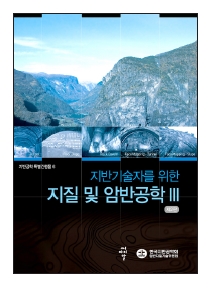
지반기술자를 위한 지질 및 암반공학 Ⅲ(제2판)
한국지반공학회는 지반공학과 관련한 다양하고 폭넓은 기술분야의 활성화를 위해 노력하며, 그 노력의 일환으로 《지반기술자를 위한 지질 및 암반공학 III》를 발간하게 되었다.이 책은 지금까지 한국지반공학회에서 이뤄낸 기술적 성과를 소개하고, 앞서 발간된 시리즈 I, II의 내용을 추가.보완하여, 내용의 질을 높였다. 또한 ‘지질 및 암반공학’을 기초와 이론편 그리고 실제와 응용편으로 나누어 구성하며, 기초이론과 다양한 적용사례를 함께 제시하고 있다. 특히 최근 많이 논의되고 있는 Face Mapping에 대한 주제내용을 소개하여 지반기술자들에게 유용하게 활용될 수 있도록 하였다.이 책이 지반공학을 전문으로 하는 많은 지반기술자들에게 실용적인 참고서가 되길 바라며, 앞으로도 ‘지질 및 암반공학’에 대한 끊임없는 연구와 활동을 통해 관련 도서가 지속적으로 발간되어 우리나라 지질 및 암반에 대한 소중한 기술자료가 되길 바란다.
Part 01 지질 및 암반공학 기초와 원리
암반공학 개론/ 지질공학과 지질모델/ 암반분류 및 평가/ 암반응력 및 파괴기준/ 암석 및 암반의 시험/ 암반구조물 해석/ 암반수리특성 및 지하수모델링/ 대심도 암반의 거동 특성
Part 02 지질 및 암반공학 실제와 응용
지반조사 방법 및 사례/ 지질리스크와 터널문제 사례/ 대단면터널 붕락 피드백 사례분석/ 도로터널 붕락사례 및 대책/ 지하구조물 설계응용/ 지하 방사성폐기물 처분시설/ 암반사면 조사 및 평가/ 암반사면 안정성 해석/ 암반사면 붕락사례 및 대책
Part 03 굴착면 관찰조사 Face Mapping
지반과 굴착면 관찰조사/ 시추코어 주상도 작성/ 터널 전단면 Face Mapping/ 터널 지질전개도 작성/ Face Mapping 사례-비탈면/ Face Mapping 사례-댐/ 터널 막장관찰 디지털 정보화 기술
저자 : (사)한국지반공학회
출판사 : 한국지반공학회, 도서출판 씨아이알
발행일 : 2021년 7월 9일
면수 : 830쪽(188*257)
정가 : 38,000원
회원동정
2021년 12월 신규가입자
12421, 김동주, 종신회원, 고려대학교 지반공학연구실 박사과정
12422, 김정규, 정회원, 사단법인 미래경제전략연구원 대표이사
12423, 김진욱, 종신회원, 고려대학교 지반공학연구실 석사과정
12424, 반창현, 종신회원, ㈜다산이엔지 인프라설계사업부 상무이사
12425, 이혜린, 정회원(여), 국민대학교 건설시스템공학부 전임연구교수
12426, 채민환, 정회원, 한국철도기술연구원 첨단궤도토목본부 연구원
12427, 강경남, 정회원, 인하대학교 스마트시티학과 박사과정
12428, 강석구, 종신회원, 충북대학교 토목공학과 석사과정
12429, 권이혁, 종신회원, 원우기술개발 설계부 부장
12430, 김병규, 정회원, 한국철도기술연구원 첨단궤도토목본부 선임연구원
12431, 박정재, 정회원, LT삼보 대리
12432, 서주연, 정회원(여), ㈜앤더비커뮤니케이션 대표이사
12433, 신영환, 정회원, 대우건설 기술연구원 선임연구원
12434, 오현철, 정회원, 대우건설 기술연구원 책임연구원
12435, 임성훈, 종신회원, 한국농어촌공사 영광지사 지역개발부 대리
12436, 장태진, 종신회원, 한국토지주택공사 대구경북지역본부 부장
12437, 정찬욱, 종신회원, ㈜정진이앤씨 대표이사
12438, 조정민, 정회원, 경기대학교 지반연구실석사과정
총 18명(정회원 10명, 종신회원 8명)

이번 호에는 정문경 회장님의 힘찬 새해를 기원하는 신년사로 시작합니다. 항상 유익한 내용을 알려주는 김영근 부회장님의 특별테마 시리즈, 이번 호 주제는 ‘복합 암반과 지오리스크’입니다. 복합암반의 공학적 거동 및 터널 사면에서 지오리스크에 대한 내용을 설명해 주고 있습니다.
기술 기사로써 ㈜다음이앤씨 기업부설연구소 팀은 지중콘크리트 박스구조물의 전단력 및 부모멘트 보강을 위한 프리플렉션 강재를 이용한 보강공법을 소개하고, 서울기술원 연구원팀은 지하 관로 스마트 모니터링 기술을 소개하고 있습니다. 또한, 에이치케이이엔씨(주) 팀은 경제적인 내부충전 합성 PHC 말뚝의 현장적용 사례를 소개하고 있습니다. 세 편의 기사 모두 우리 학회 회원님들에게 새로운 기술에 대한 좋은 정보를 제공해 줄 것 같습니다.
흙, 돌 그리고 나에서는 손수원 회원님이 지반공학적 접근 방법을 통해 선조들이 남긴 흔적을 찾아 역사를 재조명한 경험을 소개하고 있습니다. 전문위원회 클라쓰에서는 한상재 회원님과 홍기권 회원님이 지반신소재기술위원회의 역사 및 세부활동 사항에 대해 소개를 해 주셨습니다. 젊은 지반공학자 섹션에서 윤대호 회원님에 대한 소개, 신입회원 권영삼 회원님의 인사도 너무나 반가웠습니다. 종종 학회에서 뵙길 기대합니다. 윤태섭 이사님의 한국수자원학회와 공동으로 개최한 ‘하천제방 공동심포지움’ 후기는 건설분야에 있어 융합연구의 필요성을 강조하고 있습니다.
한편, 여행스케치는 바쁘게 살고있는 회원님들에게 ‘Carpe diem’에 대해 생각하고, 여유를 돌아보게 해주는 기사입니다. 아름다운 쿠바의 사진들도 마음을 편안하게 해줄 것 같습니다.
이번 호를 잘 준비해주신 편집위원님들 그리고 원고를 작성해주신 모든 분들께 다시 한번 감사드립니다. 또한, 학회지에 늘 관심 가져주시는 회원님들께 고마움을 전합니다. 2022년에는 더욱 알찬 소식을 담은 학회지가 되도록 노력하겠다는 다짐과 함께 편집후기를 마칩니다.
정종원
편집위원회 간사
충북대학교 토목공학부

